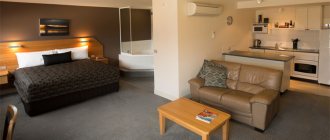In the modern world, it has become popular to purchase real estate on the 1st floor of residential buildings with its subsequent conversion into a commercial enterprise. There are also often situations when owners of commercial organizations want to convert their property into the status of a residential building. All features of such processes are prescribed in the Housing Code of the Russian Federation.
Definition, differences and directions of premises
According to Article 15 and Article 16 of the Housing Code of the Russian Federation, real estate has the following definitions:
- Residential real estate - private or apartment buildings. They are suitable for permanent residence and are also in state, municipal or private ownership of both individuals and legal entities.
- Commercial real estate is a variety of buildings or parts thereof that are used for permanent profit or commercial income.
Warning
The purpose of operating a building is to use it for its intended purpose: residential - for permanent residence, and commercial - for profit.
The main forms of difference are:
- impossibility of permanent residence in a commercial premises due to its belonging to a non-residential property;
- narrow investment direction in commercial real estate;
- payback of commercial real estate, which on average takes from 5 to 7 years;
- the purchase of commercial premises is a rather rare occurrence. Today, it is more common to rent such property.
Improper use of real estate
It is important to know that the purposeful use of residential premises as commercial premises, or vice versa, is a violation of the law.
An exception to this rule is when an individual entrepreneur engages in professional activities, for example, tutoring, legal practice, and the like. But to carry out these actions, a number of rules must be taken into account:
- there is no violation of the interests and rights of other residents;
- the entrepreneur complies with fire, sanitary and hygienic safety requirements, does not violate the rules for using the residential area and similar conditions;
- the entrepreneur does not carry out production activities.
Causes and consequences caused by non-compliance with the law
Residential premises are intended only for residence by owners, members of their families or tenants. Failure to comply with the lawful use of premises can have a number of consequences. Namely:
- fine;
- in case of misuse of residential premises by the owner and violation of the rights of other residents, the owner of the property may be deprived of all rights to own real estate;
- If a legal entity violates the rules regarding the maintenance and transfer of residential premises to commercial premises, a fine is provided.
- when people permanently reside in non-residential premises, an administrative fine is provided for non-compliance with sanitary and epidemiological requirements.
The fine may be as follows:
- To a legal entity in the amount of 10-20 thousand rubles or suspension of its activities for a period of 90 days.
- For an individual entrepreneur in the amount of 1-2 thousand or forced suspension of activities for 3 months;
- For an individual in the amount of 500 to 1000 rubles.
Is it possible to convert non-residential premises into residential ones?
It is worth knowing that until you have completed all the necessary papers, remodeled, repaired and converted the non-residential building into residential, living in it is strictly prohibited by law. That is why it is worth trying and coping with difficulties as quickly as possible. Moreover, the lawyers of the site “o-nedvizhke.ru” are ready to come to your aid at any time of the day or night.
How can you turn a non-residential space into a residential one? This simple question can sometimes cause heated disputes and take a lot of time to complete the necessary documentation. In this article, let's look in detail at the procedure for converting non-residential premises into residential ones, and also talk about why to do this at all.
26 Jun 2020 glavurist 333
Share this post
- Related Posts
- How much money can you get back when buying an apartment with a mortgage?
- What work schedules exist in the Labor Code of the Russian Federation?
- Federal Law on LLC approval of a major transaction
- What to do if the neighbors upstairs flood and don’t open the door
Conversion of residential premises into commercial real estate
The transfer of residential premises to commercial real estate is accompanied by a number of mandatory conditions:
- The location of the apartment is on the 1st floor of the building. When locating an object of the above level, it is necessary to confirm that all the premises below belong to the non-residential stock.
- The entire area of the object is translated, and not just any individual part of it.
- Availability of a separate entrance to the premises.
- If the room size exceeds 100 sq. m., it is necessary to have an emergency exit.
- The premises must not have any encumbrances or be seized.
- Accidents, reconstruction, major repairs, etc. prevent the transition of an object from one status to another.
- All persons registered in the apartment must be discharged from it.
- The layout of the premises must comply with the law.
Getting permission
To obtain permission, the owner must contact the local government department or the MFC. The application is accompanied by an application and a full package of required documentation.
The collection of documents can be carried out either by the owner himself or by his authorized representative. The list of documentation consists of:
- property rights document;
- passport;
- floor plan and explication;
- technical passport of the premises;
- a certificate from the housing department, which contains information about other premises located on this floor;
- consent of the remaining owners of apartments in this building;
- conclusion of fire safety supervision, which must confirm the compliance of the property with fire requirements;
- conclusion of the sanitary-epidemiological service;
- technical report issued by the management company;
- an extract from the house register confirming the absence of persons registered in the premises;
- a project developed for the refurbishment of a premises.
Information!
After submitting a complete package of documentation, its review takes about 45 days, then a decision is made. On average, the process of transferring the status of a residential property can take about six months.
Refusal to transfer status
The reasons for refusing to convert residential real estate to commercial may be the following factors:
- the extract from the house register is incorrect, someone else is listed as registered at the specified address;
- there is no possibility of a separate entrance;
- the building is subject to major repairs, reconstruction or demolition;
- negative decision of the council of house owners;
- non-compliance with fire and sanitary standards.
Cost of the procedure
The cost of services varies depending on the individual characteristics of each case. On average, each payment is equal to:
- redevelopment project – from 1000 rubles. for 1 sq. m.;
- floor plan - from 1200 rubles;
- those. passport and plan – from 900 rubles;
- state duty – 350 rubles;
- assistance from a notary office – from 700 rubles.
Transfer from residential to non-residential
10.03.
2018
Despite the possibility of additional benefits for the seller of an apartment when transferring the property from residential to non-residential, withdrawal from residential
and the subsequent sale of the property is not as common a scheme as it might seem at first glance.
Why? The withdrawal from the housing stock
is still a complex and rather lengthy process, requiring professional knowledge, investment of funds and time-consuming. In addition, an apartment transferred to the category of non-residential premises sharply narrows the circle of possible buyers. It should also be taken into account that for premises converted from residential to non-residential, different electricity prices apply. Therefore, in practice, most often we are dealing with a situation where a residential apartment is purchased with the aim of further removing it from the housing stock by the new owner. It is likely that the entrepreneur will need to redesign the premises so that it best suits the assigned tasks; the changes made can be simultaneously agreed upon when preparing documents for the removal of the premises from the housing stock.
Withdrawal from housing stock
- The transferred premises must not be the place of permanent residence of the citizen, and ownership must solely belong to the entrepreneur. No one should be registered in the apartment, otherwise it will not be possible to obtain permission to transfer.
- The house is not in disrepair. Most often, entrepreneurs, when organizing a store or office in a non-residential premises, begin with redevelopment, which is impossible in “emergency” buildings.
- An apartment in a residential building must be located exclusively on the first floor. Exceptions are allowed, but only when there are no residential apartments under the non-residential premises.
- Owners of adjacent apartments must give their consent to the removal of the apartment from the housing stock, preferably in writing.
How to convert residential premises into non-residential premises
- The location of the housing is on the ground floor. Re-registration of apartments located on the second or third floors is allowed, provided that only non-residential premises will be located directly below this residential premises. So, you can easily place your office on the second floor of the house if there is a grocery store on the first floor.
- Only part or a share of a residential apartment cannot be converted into non-residential. For example, you cannot change the status of one of the rooms in the apartment.
- It is necessary to have a separate entrance , or the technical ability to make independent access in the future. For example, the presence in an apartment of windows facing the courtyard allows you to equip an entrance from the courtyard. If the room is more than 100 m2, then there must be an emergency exit.
- The premises should not be subject to liens or other encumbrances . So, if you decide to remove the apartment that you purchased with a mortgage from the housing stock, you will not be allowed to do this, since the apartment will be the subject of collateral with the bank. You will have to postpone your plans until the mortgage is fully repaid and the mortgage on the apartment is terminated.
- The house is not in disrepair and does not require major repairs, reconstruction or demolition. It is more difficult to refurbish premises in a building of cultural and historical value. Approval from the Committee for the Protection of Cultural and Historical Monuments will be required.
- It will be necessary to discharge all residents from this premises in advance. Some difficulties may arise here, for example, obtaining approval for discharge from the guardianship and trusteeship authorities when the co-owner of the apartment is a minor.
- Presence of illegal redevelopment in the apartment . It will be necessary to take care of its registration in advance.
We recommend reading: Damage to property Article 167 of the Criminal Code of the Russian Federation
How to remove premises from housing stock
After receiving the package of documents, the authority involved in the transfer of premises is obliged to issue the applicant a receipt of their receipt. The receipt must contain a list of documents and the date of their receipt.
A positive or negative decision to transfer the premises to a non-residential property must be made no later than 45 days from the date of submission of documents.
Immediately after this, within 3 working days, the applicant is issued or sent by mail the corresponding document on the decision made.
In parallel with this, the body involved in the transfer of premises is obliged to inform the owners of the premises about the decision made. Next, all that remains is to register the ownership of this non-residential premises and the procedure can be considered completed.
Transfer of premises to non-residential premises
When our team of specialists is involved in this process, we provide preliminary free consultations to our clients and enter into a bilateral agreement.
This is followed by the procedure of notarization of the trust document, on the basis of which the lawyers of our company will represent your interests in the city authorities.
Next, we independently accompany the process of preparing a package of necessary documents, draw up and coordinate the project, and obtain all the required conclusions and certificates from various authorities.
Please tell me how I can transfer my apartment from residential to non-residential? I want to open a hair salon
The body carrying out the transfer of premises, no later than three working days from the date of adoption of one of the decisions specified in part 4 of this article, issues or sends to the address specified in the application to the applicant a document confirming the adoption of one of these decisions. The form and content of this document are established by the Government of the Russian Federation. The body carrying out the transfer of premises, simultaneously with issuing or sending this document to the applicant, informs the owners of the premises adjacent to the premises in respect of which the specified decision was made about the adoption of the specified decision.
We recommend reading: What you need to register a child
The removal of premises from the housing stock is not complete without carrying out calculations for heat, water and electricity supply.
After this, the transfer from residential to non-residential premises must go through several more authorities to obtain preliminary approval for connection to utilities in Sibirenergo, Gorvodokanal, State Traffic Safety Inspectorate and others.
Transfer of real estate to housing stock
To transfer a property from non-residential to residential, it must meet the following requirements:
- insulation of the room, the presence of window and door openings;
- availability of heating, sewerage, water supply, electricity and main walls;
- compliance with the standards established for residential premises.
Submitting an appeal
An application for transfer should be submitted to an interdepartmental commission, which will make a decision regarding the application. The application is accompanied by a list of documents:
- passport;
- documents confirming ownership of property;
- redevelopment project;
- conclusion of all authorities;
- floor plan, explication and plan with description;
- legal entities will also need constituent documents.
Deadline for receiving a decision
Waiting for a decision to be made also takes about 45 days. The interdepartmental commission issues a protocol indicating their consent to the transfer of real estate or refusal.
Failure may be caused by the following:
- restrictions on the right of disposal;
- unsuitability for habitation;
- lack of engineering networks and infrastructure;
- location of the object relative to the city limits.
Transfer the apartment to non-residential stock
After the relevant authority has received the entire package of documents from you, you will receive a corresponding statement with the date the procedure was started. You should receive an answer to your question no later than in a month and a half. Within three working days after this, the applicant will be sent a special letter by mail, which will indicate a decision on whether you can remove the property from the housing stock. If it turns out to be positive, then you need to begin the procedure for registering rights to non-residential premises.
We recommend reading: Receipt of an Extract from the Unified State Register by the Applicant. What is it?
1. The apartment is located on the first floor of the building (it can be higher, but there should be no residential apartments below it). In exceptional cases, it is possible to change the functional purpose of the entire building, as well as its reconstruction with a separate entrance.
Cost of services
The total cost of transferring property is about 200,000 rubles, but it varies depending on the individual characteristics of each property. The most expensive of the entire list is the plan.
Attention!
It is impossible to simply cancel the transfer of an object's status. To cancel the commission's decision, you must go through the entire procedure again.
The period of converting commercial property into residential property and vice versa takes a lot of time and money.
Therefore, before starting the process, you should think carefully about everything and consider it from all sides. If, nevertheless, the owner is ready to go through all the procedures, he has a long journey ahead, which requires patience and the availability of a reserve of funds. Share:










